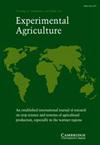雨养冬小麦基因型与环境互作及产量稳定性分析
IF 1.9
4区 农林科学
Q1 Agricultural and Biological Sciences
引用次数: 1
摘要
基因型与环境(GE)互作分析是作物育种计划中指导选择和推荐高产、稳定基因型的基础。本研究旨在量化伊朗雨养条件下转基因互作效应,并确定不同基因型冬面包小麦的产量稳定性。采用4个重复的随机完全区组设计,在2019-21三个种植季对9个试验点的24个冬小麦基因型进行了评估。采用可加性主效应和乘性相互作用(AMMI)模型和若干参数和非参数稳定性统计量对试验所得的粮食产量数据进行分析。AMMI方差分析显示,基因型、环境和GE互作对籽粒产量有显著影响(p < 0.01)。环境是主要的变异源,占总产量变异的83.5%,其次是GE效应(6.5%)和基因型效应(1.0%)。AMMI双图分析表明,G3、G23、G22、G10和G19是高产品种,在不同环境下表现稳定。基因型G14、G13、G20和G9与生长季降雨量最大的环境存在较大的正交互作用,而基因型G7、G6和G21与降雨量较小的环境存在较大的正交互作用。Spearman秩相关分析表明,AMMI稳定性值、Shukla稳定性方差(σ2 i)、Wricke生态价(W2 i)、决定系数(R2 i)、回归偏差方差(S2 di)和S2 (i)的非参数统计量与被测基因型的平均产量不相关,表明它们与静态/生物稳定性概念有关。相比之下,基因型优势指数(Pi)和回归系数(bi)与平均产量呈极显著相关(p < 0.01),符合动态/农艺稳定性概念。这些发现表明,基因型的选择应基于使用这里描述的各种稳定性参数的选择目标。综上所述,本研究选择的基因型可推荐作为伊朗或类似农业生态条件下提高粮食产量和稳定性的新品种或亲本。本文章由计算机程序翻译,如有差异,请以英文原文为准。
Genotype × environment interaction and stability analyses of grain yield in rainfed winter bread wheat
Abstract The genotype × environment (GE) interaction analysis is fundamental in crop breeding programs to guide selection and for recommendation of high performing and stable genotypes for breeding objectives. This study aimed at quantifying the GE interaction effects and determines grain yield stability among winter bread wheat genotypes under rainfed conditions of Iran. Twenty-four winter wheat genotypes were evaluated under nine test locations using a randomized complete blocks design with four replications during three cropping seasons (2019–21). The additive main effects and multiplicative interaction (AMMI) model and several parametric and nonparametric stability statistics were applied for analysis of grain yield data collected from the experiments. AMMI analysis of variance for grain yield revealed significant effects (p < 0.01) for genotype, environment, and GE interaction. The environment was the main source of variation and accounted for 83.5% of the total yield variation, followed by GE (6.5%) and genotype (1.0%) effects. The AMMI biplot analysis indicated the genotypes G3, G23, G22, G10, and G19 as high yielding with stability performance across environments. Genotypes G14, G13, G20, and G9 showed large positive interaction with the environments featuring the highest rainfall during growing season, while genotypes G7, G6, and G21 had a large positive interaction with environments with low rainfall. Spearman’s rank correlation analysis revealed that the AMMI stability value, Shukla’s stability variance (σ2 i), Wricke’s ecovalence (W2 i), coefficient of determination (R2 i), variance in regression deviations (S2 di), and nonparametric statistic of S2 (i) were not correlated with mean yield in tested genotypes, showing they are related to static/biological concept of stability. In contrast, the genotypic superiority index (Pi) and regression coefficient (bi) were significantly correlated (p < 0.01) with mean yield and corresponded to dynamic/agronomic concept of stability. These findings suggest that selection of genotypes should be considered based on selection objectives of using the various stability parameters described here. In conclusion, the selected genotypes in this study should be recommended as new cultivars or parental lines for grain yield and stability improvement under rainfed conditions of Iran or similar agro-ecologies.
求助全文
通过发布文献求助,成功后即可免费获取论文全文。
去求助
来源期刊

Experimental Agriculture
农林科学-农艺学
CiteScore
2.50
自引率
6.20%
发文量
29
审稿时长
24 months
期刊介绍:
With a focus on the tropical and sub-tropical regions of the world, Experimental Agriculture publishes the results of original research on field, plantation and herbage crops grown for food or feed, or for industrial purposes, and on farming systems, including livestock and people. It reports experimental work designed to explain how crops respond to the environment in biological and physical terms, and on the social and economic issues that may influence the uptake of the results of research by policy makers and farmers, including the role of institutions and partnerships in delivering impact. The journal also publishes accounts and critical discussions of new quantitative and qualitative methods in agricultural and ecosystems research, and of contemporary issues arising in countries where agricultural production needs to develop rapidly. There is a regular book review section and occasional, often invited, reviews of research.
 求助内容:
求助内容: 应助结果提醒方式:
应助结果提醒方式:


